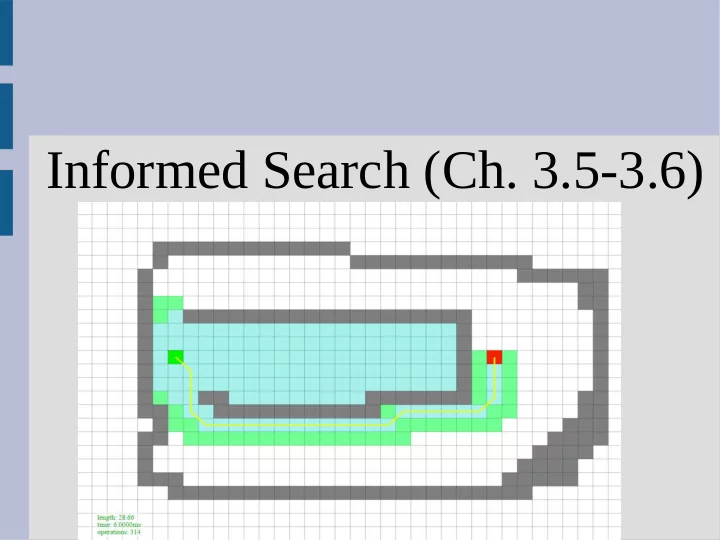

Informed Search (Ch. 3.5-3.6)
Informed search In uninformed search, we only had the node information (parent, children, cost of actions) Now we will assume there is some additional information, we will call a heuristic that estimates the distance to the goal Previously, we had no idea how close we were to goal, simply how far we had gone already
Greedy best-first search To introduce heuristics, let us look at the tree version of greedy best-first search This search will simply repeatedly select the child with the lowest heuristic(cost to goal est.)
Greedy best-first search This finds the path: Arad -> Sibiu -> Fagaras -> Bucharest However, this greedy approach is not optimal, as that is the path: Arad -> Sibiu -> Rimmicu Vilcea -> Pitesti -> Bucharest In fact, it is not guaranteed to converge (if a path reaches a dead-end, it will loop infinitely)
A* We can combine the distance traveled and the estimate to the goal, which is called A* (a star) The method goes: (red is for “graphs”) initialize explored={}, fringe={[start,f(start)]} 1. Choose C = argmin(f-cost) in fringe 2. Add or update C's children to fringe, with associated f-value, remove C from fringe 3. Add C to explored 4. Repeat 1. until C == goal or fringe empty
A* heuristic f(node) = g(node) + h(node) (estimate to-goal distance) distance gone (traveled) so far total cost estimate We will talk more about what heuristics are good or should be used later Priority queues can be used to efficiently store and insert states and their f-values into the fringe
A*
A* Step: Fringe (argmin) 0: [Arad, 366] 1: [Zerind, 75+374],[Sibu, 140+253],[Timisoara, 118+329] 1: [Zerind, 449], [Sibu, 393], [Timisoara, 447] 2: [Fagaras, 140+99+178], [Rimmicu Vilcea, 140+80+193], [Zerind, 449], [Timisoara, 447], [Oradea, 140+151+380] 2: [Fagaras, 417], [Rimmicu Vilcea, 413], [Zerind, 449], [Timisoara, 447], [Oradea, 671] 3: [Craiova, 140+80+146+160], [Pitesti, 140+80+97+98], [Fagaras, 417], [Zerind, 449], [Timisoara, 447], [Oradea, 671] 3: [Craiova, 526], [Pitesti, 415], [Fagaras, 417], [Zerind, 449], [Timisoara, 447], [Oradea, 671] 4: ... on next slide
A* 4: [Craiova from Rimmicu Vilcea, 526], [Fagaras, 417], [Zerind, 449], [Timisoara, 447], [Oradea, 671], [Craiova from Pitesti, 140+80+97+138+160], [Bucharest from Pitesti, 140+80+97+101+0] 4: [Craiova from Rimmicu Vilcea, 526], [Fagaras, 417], [Zerind, 449], [Timisoara, 447], [Oradea, 671], [Craiova from Pitesti, 615], [Bucharest from Pitesti, 418] 5: [Craiova from Rimmicu Vilcea, 526], [Zerind, 449], [Timisoara, 447], [Oradea, 671], [Craiova from Pitesti, 615], [Bucharest from Pitesti, 418], [Bucharest from Fagaras, 140+99+211+0 = 450] Goal!
A* You can choose multiple heuristics (more later) but good ones skew the search to the goal You can think circles based on f-cost: -if h(node) = 0, f-cost are circles -if h(node) = very good, f-cost long and thin ellipse This can also be though of as topographical maps (in a sense)
A* h(node) = 0 (bad heuristic, no goal guidance) h(node) = straight line distance (good heuristic)
A* Good heuristics can remove “bad” sections of the search space that will not be on any optimal solution (called pruning) A* is optimal and in fact, no optimal algorithm could expand less nodes (optimally efficient) However, the time and memory cost is still exponential (memory tighter constraint)
A* You do it! Find path S -> G Arrows show children (easier for you) (see: https://www.youtube.com/watch?v=sAoBeujec74 )
Iterative deepening A* You can combine iterative deepening with A* Idea: 1. Run DFS in IDS, but instead of using depth as cutoff, use f-cost 2. If search fails to find goal, increase f-cost to next smallest seen value (above old cost) Pros: Efficient on memory Cons: Large (LARGE) amount of re-searching
Iterative deepening A* Consider the following tree S and heuristic 4 7 A B Let’s run IDA* on this 1 8 12 5 B C G C 5 3 3 C G G 3 (tree version of last graph, G different edge cost)
Iterative deepening A* Iterative deepening, round 1: S Limit = h(s) = 7 4 7 A B Run DFS expanding nodes 1 8 12 5 less (or =) limit This is DFS FILO B C G C not finding minimum Fringe: 5 3 3 1: (S,7) C G G 2: (A,10), (B,9) 3 G 3: (A,10)
Iterative deepening A* Smallest f-cost above limit S in previous search = 9 4 7 A B New limit = 9 1 8 12 5 1: (S,7) 2: (A,10), (B,9) B C G C 3: (A,10), (C,14) 5 3 3 4: (A,10) C G G 3 G
Iterative deepening A* Smallest f-cost above limit S in previous search = 10 =limit 4 7 1: (S,7) A B 2: (A,10), (B,9) 1 8 12 5 3: (A,10), (C,14) 4: (A,10) B C G C 5: (B,7),(C,13),(G,16) 5 3 3 6:(B,7), (C,13) C G G 7: (B,7) 3 8: (C,11) G
Iterative deepening A* Smallest f-cost above limit S in previous search = 11 =limit 4 7 A B ... and repeat this 1 8 12 5 process until goal is found B C G C 5 3 3 Since search is C G G DFS, memory 3 G efficient
SMA* One fairly straight-forward modification to A* is simplified memory-bounded A* (SMA*) Idea: 1. Run A* normally until out of memory 2. Let C = argmax(f-cost) in the leaves 3. Remove C but store its value in the parent (for re-searching) 4. Goto 1
(see http://www.massey.ac.nz/~mjjohnso/notes/59302/l04.html) SMA* Here assume you can only hold at most 3 nodes in memory
SMA* SMA* is nice as it (like A*) find the optimal solution while keeping re-searching low (given your memory size) IDA* only keeps a single number in memory, and thus re-searches many times (inefficient use of memory) Typically there is some time to memory trade-off
Recommend
More recommend